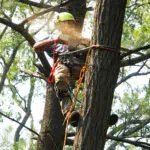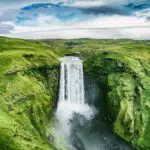International Waterfall Day is celebrated every year on June 16 to celebrate these magnificent and scenic beauties. Waterfalls are found all around the world and are incredibly important to the local communities living around them. The cascade of water is not just a wonder for the eyes but they also have a majestic quality to them that’s indescribable. Imagine trekking for miles, drenched in sweat and beaten down by the sun, only to finally walk through a clearing and look up at the sky to see what looks like water pouring from the heavens.
History of International WaterFall Day
A waterfall is usually defined as a point in a river where the water flows over a steep drop. As there are many types and methods used to classify waterfalls, what constitutes a waterfall continues to be debated. Despite being such an important part of human lives and history, waterfalls have not been very much researched, although Alexander von Humboldt did write about them in the 1820s. There is no name for the specific field of researching waterfalls but it is popular to describe studying waterfalls as ’waterfallology.’
European explorers used to document the waterfalls they came across. In 1493, Christopher Columbus wrote about Carbet Falls in Guadeloupe, which could be the first waterfall Europeans recorded seeing in the Americas. However, Geographer Brian J. Hudson suggests that it was uncommon to specifically name waterfalls until the 18th century.
This trend of, specifically, Europeans naming waterfalls is following people’s increased scientific focus on nature at the time, the rise of Romanticism, and the increased importance of hydropower due to the Industrial Revolution. However, European explorers would often ignore the names native peoples had originally given these waterfalls in favor of a more ’European’ name. For example, Scottish physician and explorer David Livingstone named Victoria Falls after Queen Victoria, even though it was already known as Mosi-oa-Tunya by the people native to the area.
Waterfall exploration continues to this day. Waterfalls are visited by people in droves mainly because they make great tourist sites; it is not just because they are beautiful, but also because they are relatively uncommon.
International WaterFall Day timeline
Belgian missionary Louis Hennepin visits North America and provides early descriptions of the Niagara Falls and Saint Anthony Falls.
Geologist William Morris Davis, known as the "father of American geography," writes and publishes an early paper on waterfalls.
American aviator Jimmy Angel flies over the waterfall now known as Angel Falls, while on a flight searching for a valuable ore bed.
The Gocta Cataracts, a perennial waterfall with two drops located in Bongara, Peru, is first announced to the world.
International WaterFall Day FAQs
How do you survive falling over a waterfall?
Jumping off a waterfall is dangerous and can be fatal. However, if you find yourself in the unfortunate situation of tripping over one, these steps might help: Take a deep breath while you’re still in the air; go over the falls feet first and jump out and away from the edge; cover your head with your arms; start swimming as soon as you hit the water to avoid hitting the rocks at the bottom and continue downstream, away from the falls.
What are the most popular waterfalls?
Waterfalls found on all continents serve as popular tourist sites. Some of the famous ones in the world are Niagara Falls, Victoria Falls, Angel Falls, Yosemite Falls, Jog Falls, Iguazu Falls, and Sutherland Falls, among others.
How are waterfalls formed?
Waterfalls are formed when the riverbed suddenly changes from soft to hard rock. Rapids are created where a fast-flowing river cuts quickly downward through a bed of hard and soft rocks. The quicker erosion of the soft rock beneath the hard rock results in the hard rock to be elevated above the stream bed. Afterward, a vertical drop will eventually (after many, many years) begin to form as more of the soft rock gets eroded.
International WaterFall Day Activities
Visit a waterfall
Fill up your car and drive to your nearest waterfall for a lovely day out. Make a picnic out of it by inviting your friends and family!
Admire them from home
Appreciate the beauty of waterfalls from the comfort of your home by hanging their pictures around your house and watching tourism videos on YouTube. Post pictures on your social media to share these wondrous sites with your friends.
Explore exotic places
Visit other places if you can’t make a trip to a waterfall. Use this day as an opportunity to satisfy your wanderlust and appease the travel-hungry explorer in you!
5 Facts About Waterfalls That Will Blow Your Mind
Angel Falls is extremely tall
Venezuela’s Angel Falls is the world's longest waterfall at 3,212 feet, with the water turning into mist before it hits the base of the waterfall.
There are thousands of waterfalls worldwide
There are still many waterfalls in the world that have yet to be recorded and named, leaving the list of waterfalls in the World Waterfall Database to be incomplete.
Niagara Falls is very clean
The water in Niagara Falls is so clean that it can even be used as drinking water.
They can be loud
The roar from the famous Victoria Falls in Zimbabwe is so loud that it can be heard from 25 miles away.
They can freeze over
Some waterfalls freeze for at least part of the year, leaving mountaineers able to climb them to practice and test their skills.
Why We Love International WaterFall Day
They’re beautiful
Waterfalls are popular tourist sites for a reason. They’re beautiful and can have an amazing de-stressing and calming effect on you. Who wouldn’t want to visit a place like that?
They have religious significance
People in different cultures also attach religious significance to waterfalls in their regions. ‘Misogi,’ which means ‘water cleansing’ in Japanese, is a popular Shinto practice in Japan where people stand under a waterfall to purify their souls.
They’re important sources of power
Hydroelectricity can be generated from naturally existing waterfalls, although most hydroelectric plants generate water from man-made falls. They are made by building dams, thus restricting the natural flow of the river into channels where the water can power turbines.
International WaterFall Day dates
| Year | Date | Day |
|---|---|---|
| 2026 | June 16 | Tuesday |
| 2027 | June 16 | Wednesday |
| 2028 | June 16 | Friday |
| 2029 | June 16 | Saturday |
| 2030 | June 16 | Sunday |










